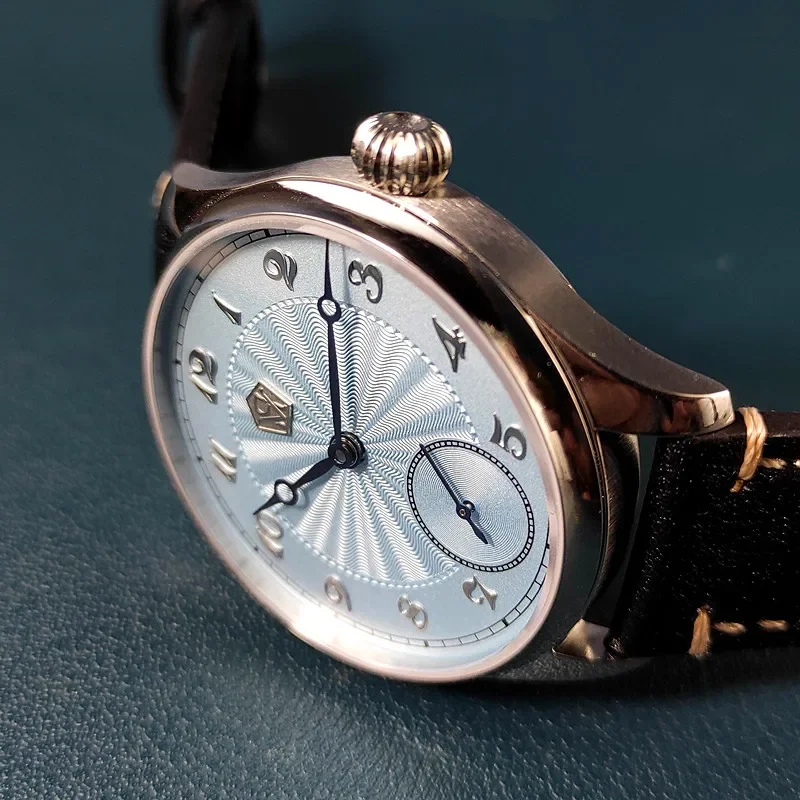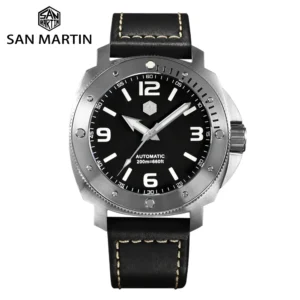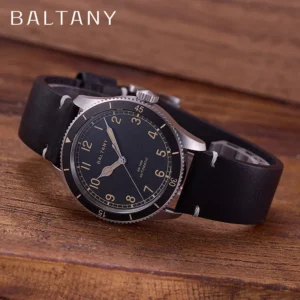The Birth of Aviation Timekeeping: Necessity Breeds Innovation
Pilot watches represent a specialized category of timepieces designed with specific features to meet the demanding requirements of aviators. Unlike traditional watches, these instruments emerged from practical necessity rather than fashion, becoming essential tools for early flight navigation and timing.
When aviation pioneers first took to the skies in the early 20th century, they quickly discovered that standard pocket watches were impractical in the cockpit environment. The challenges were numerous – pilots needed both hands for aircraft controls, cockpits were cramped, visibility was often poor, and temperatures could fluctuate drastically. Accurate timekeeping wasn’t merely a convenience but a critical safety requirement for navigation and fuel management.
This fundamental need drove the evolution from pocket watches to purpose-built wrist instruments with distinct characteristics. The connection between watches and aviation history runs deep, with each design feature addressing specific challenges encountered thousands of feet above the earth. As aviation technology advanced, so too did the complexity and capability of these specialized timepieces.
The origin of pilot watches represents one of the most purpose-driven developments in horological history, with form following function in the truest sense. The innovations created for early aviators would go on to influence watch design far beyond the cockpit, establishing enduring standards for legibility, durability, and functional design.
The First Purpose-Built Pilot Timepieces (Early 1900s – WWI)
The history of dedicated pilot watches begins with a friendship between pioneering aviator Alberto Santos-Dumont and watchmaker Louis Cartier. In 1904, Santos-Dumont complained about the difficulty of checking his pocket watch while maintaining control of his aircraft during flight. Cartier’s solution was the Santos wristwatch, arguably the first timepiece specifically designed for aviators, featuring a square case and exposed screws that would influence watch design for decades.
This early innovation addressed several critical needs: the wristwatch format kept both hands free for aircraft controls, a square dial maximized legibility, and reinforced construction withstood the vibrations and shocks of early flight. The transition from cockpit to icon had begun, with practical needs driving every aspect of design.
World War I accelerated the development and adoption of pilot watches. Military aviation units needed reliable instruments that could withstand battlefield conditions. Watch manufacturers responded with timepieces featuring oversized dials (often 40mm or larger – enormous by standards of the era), high-contrast numerals, and luminous materials for nighttime readability. Secure leather straps replaced fragile chains, while crowns grew larger to allow operation while wearing gloves.
Military specifications formalized these requirements, leading to standardized designs that prioritized functionality and reliability over aesthetics. The basic design language established during this period – large, legible dials with high contrast and secure attachment methods – remains fundamental to classic pilot watches today, demonstrating how deeply these early innovations influenced the category.
Navigation Revolution: Watches as Cockpit Instruments (1920s-1930s)
The 1920s and 1930s marked a transformative period when pilot watches evolved from simple timekeepers into sophisticated navigation instruments. As aviation advanced from short flights to transcontinental and transoceanic journeys, navigation challenges grew exponentially. Pilots required more than basic time readings – they needed precision instruments capable of complex calculations.
This era saw the development of specialized complications designed specifically for aviators. The most notable was the Hour Angle Watch, developed in collaboration with famed aviator Charles Lindbergh after his historic transatlantic flight. This revolutionary timepiece allowed pilots to determine longitude based on celestial observations when used with a sextant and radio time signals – essentially functioning as a mechanical GPS predecessor.
Rotating bezels emerged as another crucial innovation, enabling pilots to perform various calculations and track elapsed time for navigation and fuel management. These bezels featured specialized scales for computing airspeed, distance, and fuel consumption – transformations that expanded the pilot watch from mere timekeeper to multifunctional flight computer.
The importance of these advancements cannot be overstated in the history of aviation safety and capability. Before electronic navigation systems, historical aviation timing instruments were the difference between reaching a destination safely and becoming hopelessly lost. Watches designed during this period addressed very specific navigation problems, with each feature serving a practical purpose for long-distance flight.
Military Precision: The Standardization of Pilot Watches (1939-1945)
World War II represented a pivotal moment in pilot watch development, as military needs drove unprecedented standardization and production. The most influential design from this period was the German B-Uhr (Beobachtungs-Uhren or “Observation Watch”), produced to exacting military specifications for Luftwaffe navigators.
The B-Uhr specifications were remarkably precise and technically demanding:
- Massive 55mm case diameter for maximum legibility
- High-grade manual-wind movements with chronometer certification
- Antimagnetic protection to prevent compass interference
- Oversized “onion” crowns for operation with gloved hands
- Hacking seconds function for precise synchronization
- Two distinct dial patterns: Type A (hours 1-12) and Type B (minutes 5-55 with smaller inner hour track)
Allied forces developed their own specifications, with the American A-11 and British Mark X establishing distinctive standards. These watches featured black dials with white numerals, center seconds hands, and robust cases designed to withstand combat conditions.
The military demands of this era solidified design elements that continue to define pilot watches today. Features like the triangle marker at 12 o’clock, highly legible Arabic numerals, and sword-shaped hands became standard across various manufacturers. The military-inspired automatic watches in today’s market owe their distinctive aesthetic to these wartime specifications.
The Iconic Features of Classic Pilot Watches
What makes a pilot watch immediately recognizable are the distinctive features developed to address specific aviation challenges. Each design element serves a purpose beyond aesthetics:
Enhanced Legibility Features:
– Large Arabic numerals (typically 1-12) in high-contrast colors
– Sword or baton-shaped hands with significant size difference between hour and minute
– Triangle marker at 12 o’clock for instant orientation
– Luminous material on hands and indices for nighttime visibility
– Minimal decorative elements that might compromise readability
Practical Operation Elements:
– Oversized crown for manipulation while wearing gloves
– Extended leather straps designed to fit over flight jacket sleeves
– Shatterproof crystal materials to withstand pressure changes and impacts
– Anti-magnetic protection to prevent interference with navigation instruments
– Secure fastening systems to prevent watch loss during high-G maneuvers

The heritage behind pilot watch features reveals how thoroughly practical considerations shaped their design. While modern aviation has largely moved beyond mechanical timekeeping instruments, contemporary automatic pilot watches maintain these traditional elements both for their proven functionality and historical significance.
Each feature represents a solution to a specific challenge faced by pilots, from the need to read time at a glance in turbulent conditions to operating the watch while wearing bulky flight gloves. The distinctive aesthetic of pilot watches emerged not from stylistic preferences but from the uncompromising demands of aviation safety.
Post-War Evolution: Chronographs and Specialized Complications
The post-World War II era saw pilot watches evolve beyond basic time-telling to incorporate advanced timing functions. Chronographs – watches with stopwatch capabilities – became increasingly important for aviation as they allowed pilots to time flight legs, approaches, and fuel consumption with precision.
The flyback chronograph represented a significant advancement specifically designed for aviator needs. Unlike standard chronographs requiring multiple pushes to reset and restart timing, flyback mechanisms allowed pilots to reset and restart with a single button press – a crucial advantage when performing rapid calculations during critical flight phases.
Military specifications continued to drive development, with watches like the Mark 11, commissioned by the British Ministry of Defence, establishing new standards for antimagnetic protection and accuracy. These specifications influenced civilian models as manufacturers applied military-grade durability to watches available to the general public.
Specialized bezels evolved to accommodate aviation calculations. The E6B slide rule bezel, featured prominently on watches like the Breitling Navitimer, effectively transformed the wristwatch into a circular slide rule capable of multiplication, division, and various aviation calculations including fuel consumption, airspeed, and distance conversions.
Chronograph pilot watches from this era combined traditional legibility with new capabilities for precise timing. The enduring legacy of chronograph complications in pilot watches demonstrates how these functional tools continued evolving to meet the changing demands of aviation.
The Jet Age and Global Travel: GMT and Multiple Time Zones
The advent of jet travel in the 1950s and 1960s fundamentally changed aviation and created new challenges for pilots. Crossing multiple time zones at unprecedented speeds required new timekeeping solutions. The most significant development was the GMT (Greenwich Mean Time) function, allowing pilots to track two time zones simultaneously using a single watch.
The GMT complication typically features an additional hand that rotates once per 24 hours, pointing to a 24-hour scale on the dial or bezel. This allowed pilots to track local time with the standard hands while maintaining awareness of GMT (later UTC) – the universal aviation reference time – with the additional hand.
As commercial aviation expanded, these watches found broader appeal among civilian travelers, business professionals, and aviation enthusiasts. The ability to track multiple time zones proved useful beyond the cockpit, contributing to the growing popularity of pilot watch design elements in mainstream timepieces.
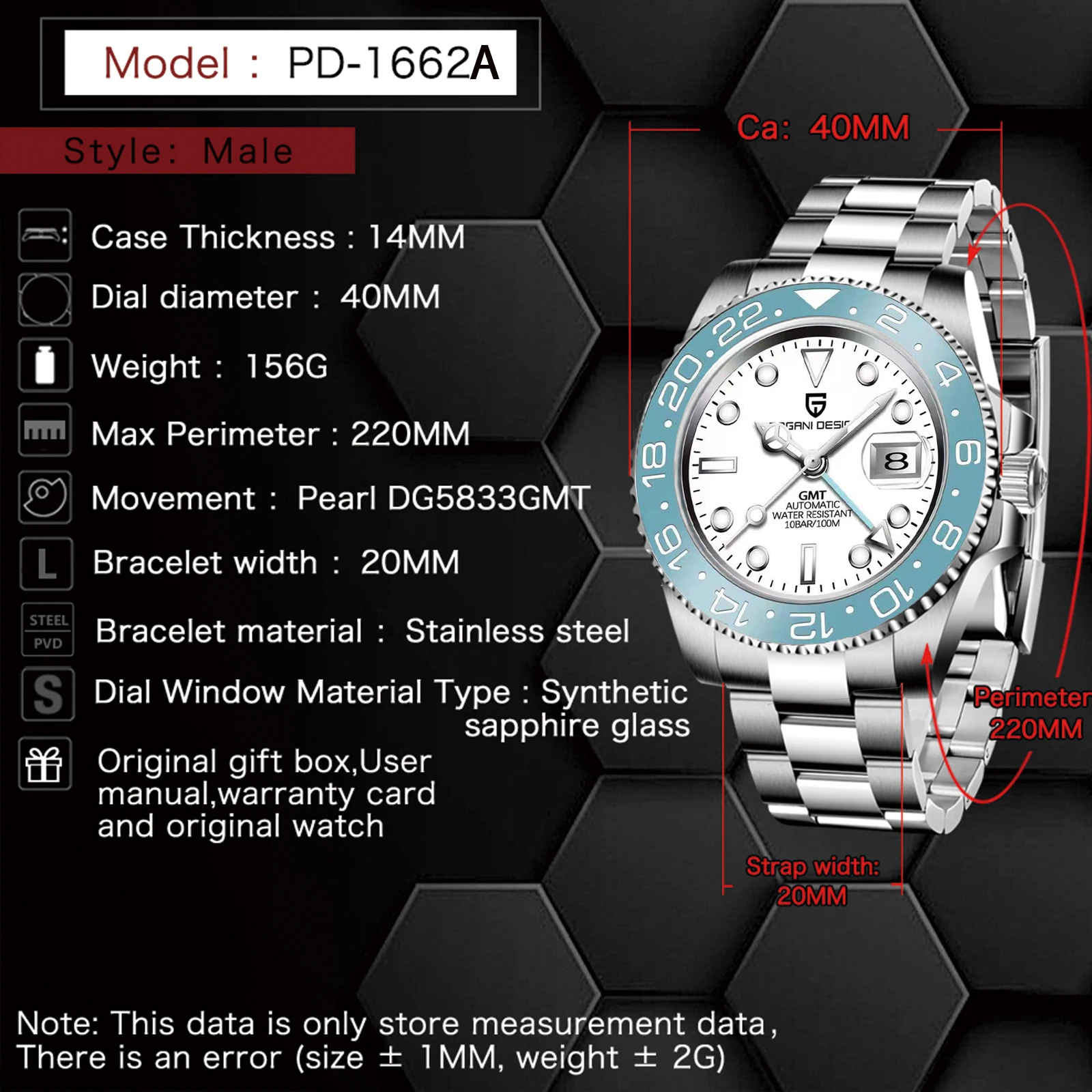
For intercontinental pilots, the ability to track home time, destination time, and GMT simultaneously became invaluable for flight planning and crew scheduling. Modern GMT pilot watches maintain this tradition while incorporating contemporary materials and movements, reflecting the continued relevance of this aviation-inspired complication in today’s globally connected world.
Material Innovations and Modern Manufacturing
While pilot watches maintain their distinctive visual identity, the materials and manufacturing methods used to create them have evolved dramatically. Contemporary pilot watches benefit from advancements that enhance performance while preserving traditional aesthetics.
Case materials represent one of the most significant areas of innovation:
– Traditional stainless steel has been joined by lightweight titanium, offering comparable strength at roughly half the weight
– Ceramic compounds provide exceptional scratch resistance and maintain their appearance over decades of use
– Carbon composites deliver extreme lightness and strength while also providing inherent antimagnetic properties
– PVD (Physical Vapor Deposition) coatings create durable, non-reflective surfaces ideal for cockpit conditions
Crystal technology has similarly advanced:
– Acrylic crystals of early models have largely been replaced by sapphire, offering superior scratch resistance
– Anti-reflective coatings eliminate glare that could compromise legibility
– Improved impact resistance addresses the harsh conditions of aviation environments
Luminous technology has transformed dramatically, moving from potentially hazardous radium compounds to safe, long-lasting materials like Super-LumiNova that provide superior brightness without radioactivity. Modern manufacturing precision allows for more consistent application of these materials, enhancing legibility in low-light conditions.
Titanium automatic watches represent a perfect example of how traditional design can be enhanced through material innovation. The lightweight properties of titanium address the size concerns of traditional pilot watches, making larger cases more comfortable for everyday wear while maintaining the visual impact of historical designs.
Modern Pilot Watches: Heritage Meets Innovation
Contemporary pilot watches represent a fascinating balance between honoring historical designs and incorporating modern technology. Today’s manufacturers face the challenge of preserving the distinctive character of classic pilot watches while enhancing their performance for modern wearers.
Many leading watchmakers maintain heritage collections that directly reference historical models, sometimes reproducing them with remarkable accuracy while discreetly updating materials and movements. These watches celebrate the design evolution across different aviation eras while offering modern reliability.
Technical advancements in modern pilot watches include:
– High-performance automatic movements with extended power reserves
– Enhanced shock resistance systems protecting against modern aviation stresses
– Superior antimagnetic protection addressing contemporary electronic environments
– Improved water resistance for all-condition reliability
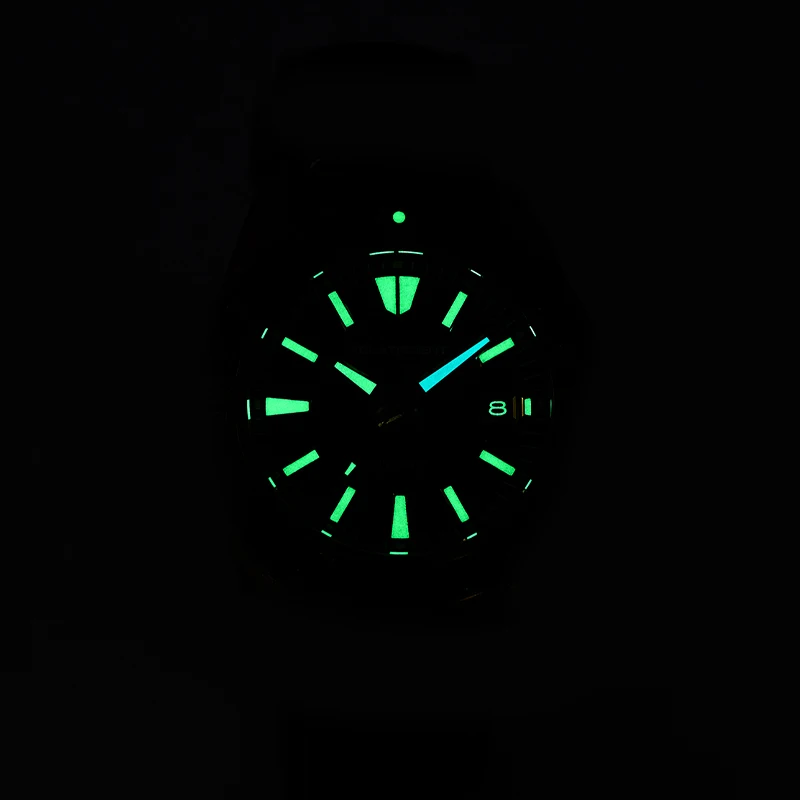
Military Inspired Automatic Watches, Rugged Automatic Watches, Tactical Automatic Watches
Price range: $852.14 through $994.60 Select options This product has multiple variants. The options may be chosen on the product pageAutomatic Chronograph Watches, Chronograph Pilot Watches
Price range: $233.36 through $237.58 Select options This product has multiple variants. The options may be chosen on the product pageClassic Automatic Dress Watches, GMT Automatic Watches, GMT Pilot Watches
Price range: $1,240.86 through $1,463.33 Select options This product has multiple variants. The options may be chosen on the product pageBronze Automatic Watches, Military Inspired Automatic Watches, Professional Spec Dive Watches
Price range: $1,442.21 through $1,442.82 Select options This product has multiple variants. The options may be chosen on the product pageProfessional Spec Dive Watches, Titanium Automatic Watches
$574.74 Select options This product has multiple variants. The options may be chosen on the product pageClassic Pilot Watches, Military Inspired Automatic Watches
$561.00 Select options This product has multiple variants. The options may be chosen on the product page
While electronic flight instruments have largely replaced mechanical watches for primary navigation and timing, pilot watches remain relevant as backup instruments and continue to embody the spirit of aviation. Their straightforward functionality, exceptional legibility, and robust construction make them practical timepieces for numerous professions beyond flying.
Sharp Aspect’s collection of pilot-inspired timepieces maintains this balance of heritage and innovation, offering watches that honor aviation history while incorporating modern watchmaking advancements. These pieces connect wearers to a rich tradition of purposeful design while providing reliable daily performance.
Beyond Function: The Cultural Impact of Pilot Watches
Beyond their practical applications, pilot watches have achieved remarkable cultural significance. They represent more than just timekeeping tools – they embody adventure, precision engineering, and connection to aviation heritage.
The aesthetic influence of pilot watches extends far beyond aviation-specific timepieces. Design elements like high-contrast dials, prominent numerals, and oversized crowns have permeated mainstream watch design, appearing in countless models with no direct connection to flying. This widespread adoption speaks to the enduring appeal of the pilot watch aesthetic.
For collectors and enthusiasts, pilot watches offer tangible connections to aviation milestones and military history. Original military-issue pieces command significant premiums, while heritage reissues allow enthusiasts to experience these designs without the scarcity and fragility of vintage models.
The symbolism of pilot watches remains powerful – they represent human ingenuity, adventure, and the golden age of mechanical instruments. In a world increasingly dominated by digital devices, the continuing appeal of these mechanical tools highlights our emotional connection to purpose-built analog instruments with clear, understandable functions.
The specialized features in contemporary pilot watches continue to evolve while maintaining connections to this rich heritage, demonstrating how deeply these timepieces have become embedded in watchmaking culture.
Collecting Vintage Pilot Watches: What to Know
For those interested in acquiring vintage pilot watches, several key considerations can guide your search:
Authentication Factors:
– Period-correct movements matching known specifications
– Appropriate case materials and manufacturing techniques
– Original dial patina versus refinished surfaces
– Correct hand shapes and luminous material
– Serial number verification against military records (for issued pieces)
Important Models to Consider:
– B-Uhr observation watches from original contractors
– Mark XI and other military-specification watches
– Early civilian chronographs with aviation functions
– Post-war professional pilot models with navigation features
Condition Considerations:
– Original parts versus replacement components
– Appropriate patina versus damage
– Movement service history and current functioning
– Water or moisture damage to dials and movements
– Originality of case finishing
Many collectors begin with modern reissues of historical models before venturing into vintage pieces, allowing them to appreciate the designs while avoiding the maintenance challenges of older watches. Research is essential, as the military provenance of many pilot watches makes them particularly subject to counterfeiting and inappropriate restoration.
Maintaining the Aviation Legacy: Pilot Watch Care
Proper maintenance ensures both vintage and modern pilot watches continue functioning reliably. These robust timepieces benefit from consistent care routines:
For mechanical pilot watches, regular service intervals of 5-7 years are recommended to maintain accuracy and prevent wear. Vintage pieces may require more frequent attention, particularly those with historical luminous materials that can deteriorate over time.
Antimagnetic features should be preserved during servicing, as modern repair environments contain numerous magnetic fields that can compromise these protective systems. When choosing a watchmaker, select one familiar with historical pilot watch specifications.
Storage considerations include keeping watches away from strong magnetic fields, maintaining moderate humidity levels, and ensuring regular winding of mechanical movements. For vintage pieces with aged luminous compounds, professional assessment of safety may be necessary.
Water resistance in vintage pilot watches should never be assumed, regardless of original specifications, as gaskets and seals deteriorate over decades. Modern pilot watches typically offer improved water resistance but still require periodic testing if regularly exposed to moisture.
Are Pilot Watches Still Relevant in Modern Aviation?
Despite the prevalence of digital instrumentation in modern cockpits, mechanical pilot watches maintain certain advantages that ensure their continued relevance:
Independence from electrical systems provides a reliable backup that doesn’t require batteries or power from aircraft systems. In emergency situations where electronic systems fail, a mechanical timepiece can provide critical timing information for navigation and procedures.
Professional pilots often cite the glance-readability of traditional pilot watch designs as superior to digital alternatives, particularly in turbulent conditions or variable lighting. The high-contrast hands against a simple dial can be registered almost instantaneously.
Flight time logging, holding pattern timing, and fuel management calculations can still be performed efficiently using chronograph and bezel functions. Many pilots maintain these mechanical skills even while primarily using digital systems.
Military aviation continues to specify mechanical watches for certain operations, recognizing their reliability in electromagnetic environments where electronic devices may be compromised. This ongoing professional application demonstrates that pilot watches remain functional tools rather than mere fashion accessories.
The enduring connection between horology and aviation ensures that pilot watches will continue evolving alongside advancements in both fields, maintaining their distinctive character while incorporating new technologies and materials that enhance their performance.

